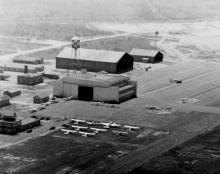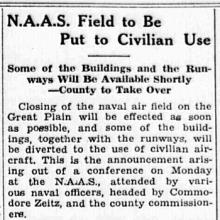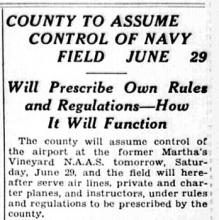Six years after a master plan was commissioned for the Martha’s Vineyard Airport in an attempt to make an asset from an eyesore, significant changes are beginning to take shape.
The first tenant in a new 63-acre airport business park off Barnes Road is already on the site and, when utility lines are put in place sometime in the year ahead, other businesses are expected to move in rapidly.
At the same time, county airport commissioners are beginning to take action. They’ve notified airport park tenants that at least one of the many dilapidated World War II buildings at the airport will be coming down, and that probably the rest of the old buildings will be destroyed in time.
The commissioners are also giving serious consideration to updating that master plan commissioned in 1978, and then implementing it.
“For too many years there’s been too much talk and not enough action at the airport,” says John Alley, chairman of the Dukes County Commissioners. “I think now we’re going to turn it around.”
The airport finds itself caught up, however, in a bit of a Catch-22, one that will make it difficult to bring about the dramatic changes everybody wants. It will take new, active businesses and a new look at the airport to generate excitement about the airport. But businesses and Island taxpayers, who eventually will be asked to help pay the bills, will want reason to believe in the airport before making commitments.
Meanwhile, the planes keep flying in and out, more and more of them each year.
The 1978 master business plan predicted that by the end of this century passenger traffic will have doubled from 29,000 visitors to 55,000 visitors.
The report declares:
“In view of the cost of flying to the Vineyard compared to the cost of coming by ferry, it would seem clear that the airlines are much more likely to bring in the quality tourist than the ferries, and therefore Island policy should be to encourage air travel as much as possible.”
Jim Mitchell, who took over as airport manager last spring, puts the issue in plain terms.
“A lot of people want to fly,” he says. “PBA is doing a tremendous job. The passenger count in one month last summer was 10,000. And we’ll continue to grow.”
The Martha’s Vineyard Airport is divided into two areas now to coordinate planning. There is the old airport complex and the new business park. A special airport advisory committee has been set up to tackle both areas.
The business park, 63 acres off the County Road, is designed to attract year-round Island businesses and employ Islanders year-round. Expectations are high that the business park will do just this because of its central location on the Island, and its relatively low rental and leasing deals.
The business park also is among the few areas left where Island business can expand. “Most of the business areas in the three down-Island towns are saturated,” says Mr. Alley.
A survey of Island businessmen shows that the business park will have many tenants once it gets going, according to Doug Ewing of the Martha’s Vineyard Commission, who is working with the airport advisory committee.
The Steamship Authority has expressed strong interest in building an advance reservation center in the business park, an operation that would draw many customers into the area.
But improving the airport terminal area presents a more challenging problem than building the business park. A new terminal area, which everybody seems to acknowledge is long overdue, will cost at least $3 million. Grants are available to defray a large part of the cost, but the county will likely need to come up with a large share as well, and the county is financially strapped.
The argument for spending the money is that investment is needed to make the airport a profit center in its own right.
“It’s a multi-million-dollar piece of real estate,” says Mr. Mitchell. “It’s the second mode of transportation off and on this Island. The present terminal does not reflect what we’d like to reflect to the visiting public. And this airport can definitely be an asset as opposed to a liability.”
The airport has recently been ending up in the red year after year, and, with all the talk about a new terminal, new and improved parking areas, improved runways, the future influx of air-related industry and business, the immediate challenge of the county is to have the airport turn a profit and begin proving its value.
“We have begun to turn the financial picture of the airport around,” Mr. Alley says. He said the airport should break even or show a slight profit this year, and then begin showing a bigger and bigger profit.
From the time the county took over the airport from the military in 1946 the effort has been hit or miss, Mr. Alley says, and even after the 1978 master plan was completed, little happened.
“But it isn’t so far away as it was,” he says. “It really isn’t.”









Comments